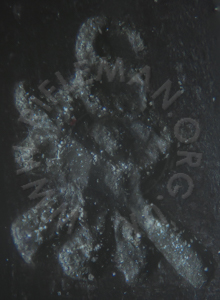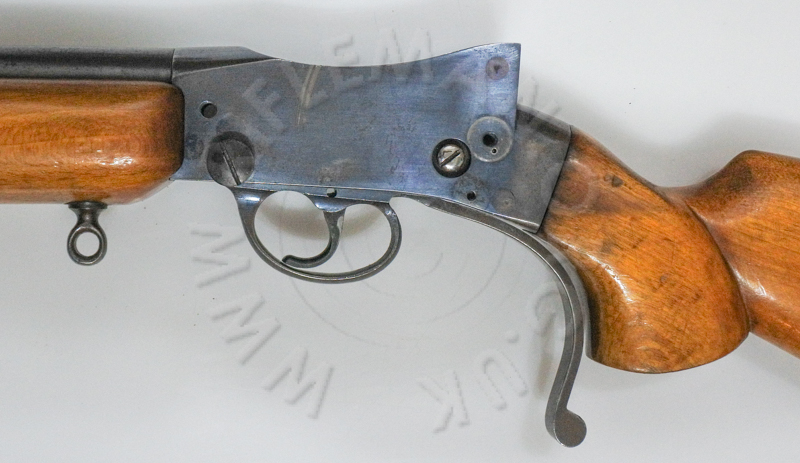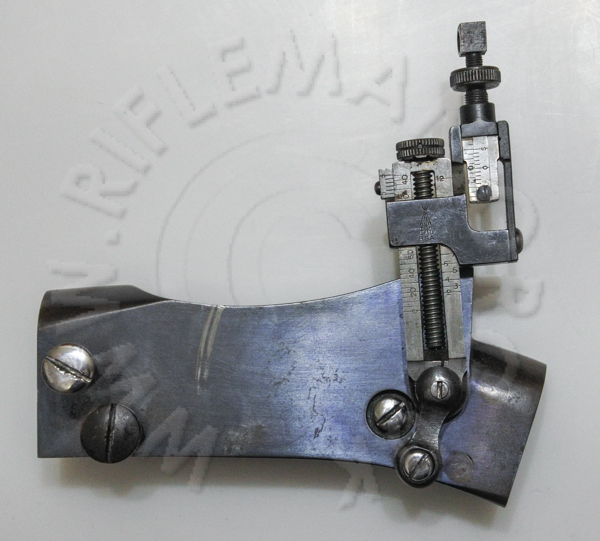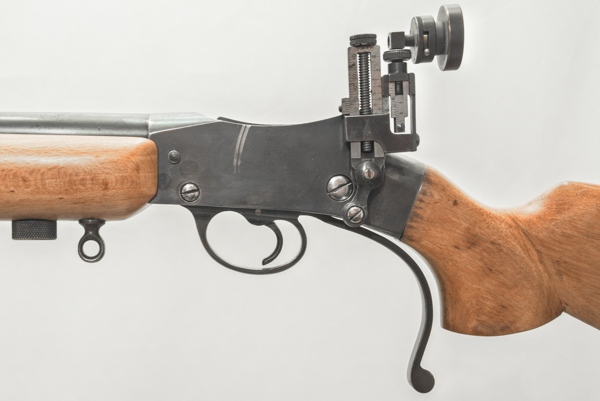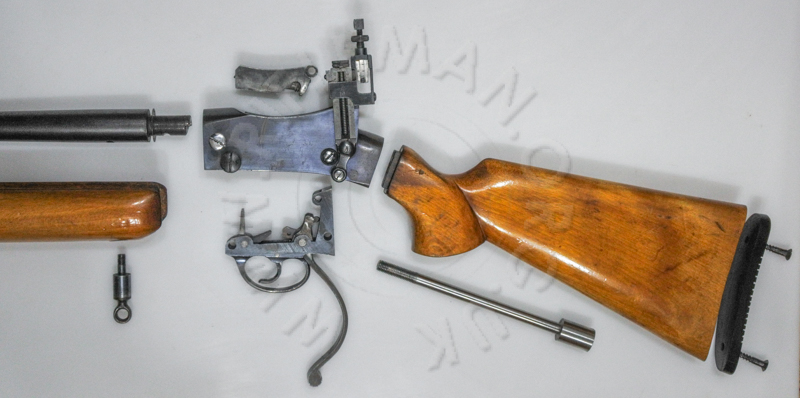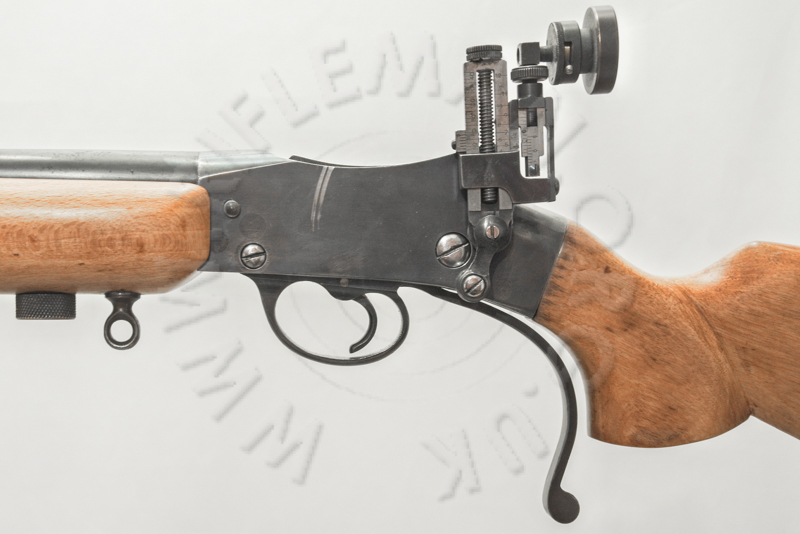H. & F. Martini Target Rifle
Drag horizontally to rotate subject. Click to zoom and drag to pan.
Full screen viewing from expansion arrows.
This very unusual custom-made .22RF target rifle is marked with the gunmaker's name of "H. & F. GRAVESEND". We have been unable to identify these gunsmiths from that Thameside town in Essex, and hope that one of our readers may be able to shed some light on the subject.
The only reference to a manufacturer is the stamping "H. & F. GRAVESEND"
on the lower edge of the left-hand side-plate beside the trigger-guard.
The rifle carries, under the barrrel near the breech, the tiny proof mark, only about an eighth-of-an-inch square, shown below, and has been photographed through a microscope.
A quick check with our "Date your Rifle" page, indicates that the letter "S" above the crossed 'scimitars' affords the rifle a proof date of 1938/39, immediately prior to the Second World War. We have never before seen such a peculiarly fabricated rifle of this type.
The internal action is very similar to that of the contemporary BSA Martini or Vickers Martini rifles, and the action body is of similar profile to the BSA Model 15 rifle, but without that rifle's rear-sight dovetailed to the upright rear face of the receiver body.
When acquired, some years ago, the rifle was without sights, leaving us with a conundrum as to what the sighting arrangement would have been.
The radiussed witness mark at the top of the receiver side plate, just ahead of the trigger, suggested some kind of folding sight to have been used, and a search through a plethora of early models came up with the Model 9G, manufactured by the Birmingham Small Arms Company.
The 9G sight was also earlier used on the C.L.L.E., or Charger-loading "Long" Lee-Enfield.
When offered up to the above Martini action, the elevation adjustment knob precisely tracked the witness mark when pivotted from the large hole, which is evident with a circular witness mark, half way up and towards the rear of the side plate.
That threaded hole, in conjunction with the similar smaller one, lower down and to the left, reminded us of the layout of the fastening of the safety catch on the S.M.L.E., (the "Rifle, Short, Magazine Lee-Enfield"), on which a spring steel 'dumbell' holds the catch in position.
It was necessary to make up spacers that must have originally been present to offset the sight sufficiently for it to clear the receiver body, with an original Lee-Enfield "dumbell" holding the sight's pivot in place.
On the Lee-Enfield, the dumbell has splines on the upper section that locate in grooves in the safety catch lever, this locks the safety catch in the forward and rearward Off/On positions with 90 degrees rotation betwixt.
When the BSA Model 9G target sight is fitted, the grooved spacer is replaced by the similarly grooved base pivot of the sight, which then indexes either horizontally for "stowage" or upright in the target shooting position.
Ironically, these folding target sights have become so sought-after by custodians of both Long and Short Lee-Enfields that they now command figures on internet auction sites that one would hardly believe. Such sights as the BSA and A.G. Parker or Parker-Hale No.9 models are today worth as much as this poor old martini rifle; which is no doubt why it was removed in the first place.
It may not be evident in our photographs, but the body is made of just four separate pieces; being the front and rear centre blocks, sandwiched between the two heavy side-plates, and rivetted together.
The laminations can just be seen in the image above.
The configuration is that of a "take-down" rifle, with the barrel screwing into the threaded front centre block of the receiver body. However, it is a very long and fine thread, requiring many turns to separate the barrel and action, and taking rather longer to manage, an awkwardly at that, if the rifle were to be assembled and then broken down for every visit to a range.
It may have been more convenient for travel on public transport, but would not have been entertained by a car owner. There is also a loose thin shim breeching washer that could easily be lost, rendering the barrel seating out-of-line, and the ........... overtight.
Nonetheless, the outward appearance and finish of the rifle is very acceptable, and the gunsmithing workmanlike. We have yet to test fire the rifle to discover its accuracy, but the barrel has been sleeved by A.G Parker, and the muzzle is stamped with their "PARKERIFLING" mark.
The thirty-inch tapered barrel is made in two sections, with the rear third being the threaded chamber section, which is butted to the longer forward section to the muzzle. Whether there is a shouldered joint is impossible to tell, but the whole is presumably stiffened by the sleeve tube.
Below is the disassembly of the complete rifle.
The fore-sight is the BSA No.2 tube sight also marketed by Parker-Hale as the FS22a, however, the dovetailed mounting block on the rifle is narrower than the transverse dovetail of the sight, and there may have been a smaller sight, perhaps even an open model, originally fitted.
Below: the action section returned to its probable original condition.
Return to: TOP of PAGE
See this website's Raison d'être


